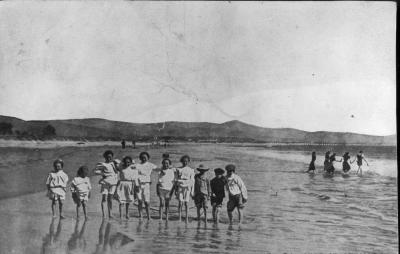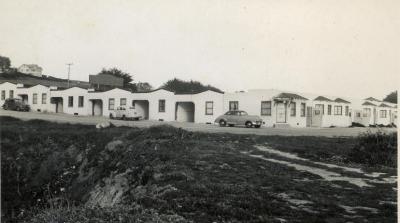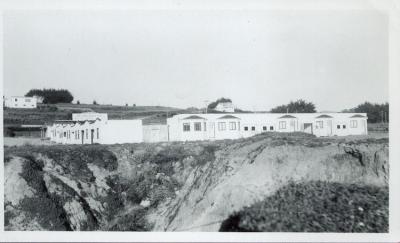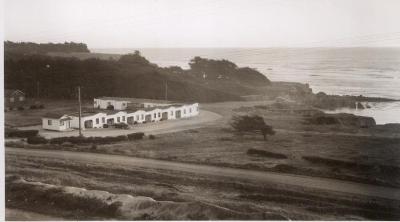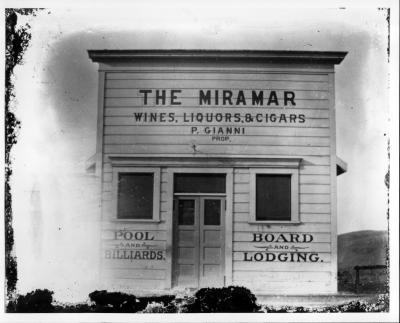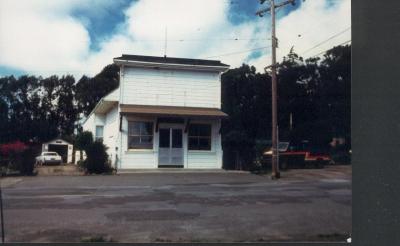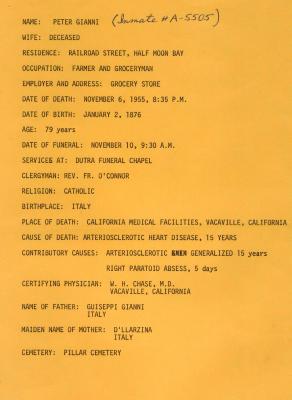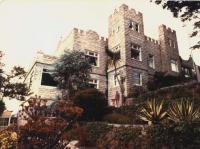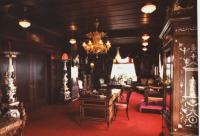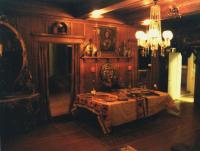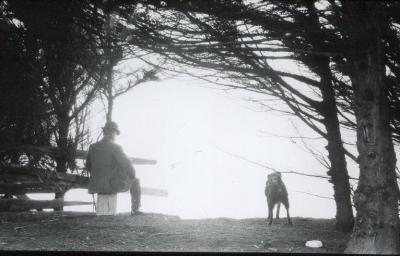Old Princeton
How could you forget….
Dan’s Motor Court……………. where, when the days of Moss Beach’s drive-in motel were numbered –(the land overlooking the ocean was worth more as residential property)– the art on the walls consisted of photographs snipped out from magazines and taped to the walls. Gone now, I miss seeing Dan’s when I drive through Moss Beach. All we have is this photographic memory.
Front, Back….and Sideways….and, yes, I once slept there…
What Henry Told Me
When I met Henry Debenedetti in the 1970s, the colorful history of Miramar Beach was tugging at my curiosity strings.
I already knew about Maymie, the red-haired madamâwho ruled not only the prohibition era roadhouse that her lover-carpenter built for herâbut her powers (political-financial) seemed to extend southward into the little town of Half Moon Bay.
My evidence: I have had reliable reports from those close to the action that Maymie was often seen in the company of the townâs banker and his wife and friendsâa strictly spreadsheet type of relationship.
Miramar was at the center of everything. It had even been chosen as the best spot for a tiny port, the first one on the Coastside, despite the unpredictable winds that finally closed it down.
There was one mystery I hadnât solvedâa name locals attached to Miramar, a name I wasnât getting right.
âPeach Chiano,â? thatâs what I thought I heard locals call himâbut I knew that couldnât be someoneâs name. Maybe a nickname?
Soâwhen I encountered Henry in the library after the Thanksgiving of 1976, Miramar and âPeach Chianoâ? were on my mind.
Henry ticked off a list of things he remembered about Miramar. The one that grabbed my attention most was âPete Gianni. He had a wild temperâ¦.â? And he was involved in a horrendous crime that shocked the community after WWII.
Henry cleared it all up. Pete Gianni was my man.
I took a quantum leap forward in my quest when Spanishtown Historical Society member âPatsyâ? Dutra gave me a significant set of clues. Her then 89-year-old father, Mac, sometimes called âDukeâ?, had owned the townâs funeral parlor.
Patsy furthered my investigation by giving me the funeral homeâs report on Pete Gianni, then long deceased.
Gianni was well known on the Coastside, the owner of a grocery store in Miramarâwhere local Italians gathered to dance on weekends. Some described him as kind and quiet, others as easily incited. As long as his business prospered, the widower seemed content.
But after WWII ended, and the soldiers stationed on the Coastsideâmany of whom frequented Gianniâs store scattered to begin new lives elsewhere– Pete Gianniâs grocery business slipped sharply and he considered taking on a partner.
The 72-year old Gianni knew and respected the Shaw family of El Granada, 36-year-old Lincoln, his 33-year-old wife Agnes, and teenage daughter Carolyn. Lincoln had attended schools in San Mateo County, including the junior college and Agnesâs father was a respected Burlingame contractor.
During the war fish oil was in high demand and Lincoln made a good living working as a commercial fisherman at Princeton. When the war ended, so did the demand for fish oil and Shaw looked for new opportunities. To save money, the Shaws moved in with their Burlingame relatives.
Pete Gianni and Lincoln Shaw cut a deal as Lincoln paid the grocery owner $1000 for an interest in the business. The Shaws would continue to live and commute to Miramar from Burlingame. Under the new proprietors, the grocery store thrived and prospered.
Instead of feeling proud, Gianni seethed, feeling he had been cheated in some way.
After the first of the year in 1947, neighbors heard the angry voice of Pete Gianni at the grocery store. The old man was armed with a shotgun, yelling at Lincoln Shaw, angry about the rent, saying he wasnât being paid enough.
Shots rang out. Lincoln was mortally wounded. Gianni spun around, pointed the weapon at Agnes and her daughter, Carolyn, threatening them but he didnât shoot. Running out of the store, he drove away in his car, the destination his longtime friend and veteran Redwood City criminal attorney Joseph Bullock, also known as the âverbal volcanoâ?.
But in the end there wasnât a trial. Pete Gianni pleaded guilty to murder and was sentenced to prison, passing away at the Vacaville Medical Facility in 1955.
Pete Gianniâs horrific crime stunned the Coastside community, and 20 years after his death, everyone who lived in Half Moon Bay remembered his name.
(Photos, Spanishtown Historical Society, Patsy Dutra)
Note: the second photo is of the Gilles Grocery Store in Miramar, last time I saw it it was a private residence and in the hands of the Gilles family.
And then along came Sam Mazza…to save Pacifica’s Castle: Part III
And then along came Sam Mazza to save Pacifica’s mysterious castle– a full time, extremely successful San Francisco painting contractor and equally successful, part time modern “Knight in Shining Armor”.
It was 1957, when, according to Sam’s brother, Angelo, who can often be found puttering in the castle’s gardens, “Sam was driving down to Nick’s Rockaway Restaurant, and he had a few fizzes and he spotted this concrete structure engulfed in weeds about six inches high. After inspecting it, he bought it for about $29,000 and flew a flag from the roof that said, ‘Sam’s White Elephant’.”
But it really wasn’t a “white elephant”. Sam saved Pacifica’s castle and the castle was good for him.
(Sadly, Mr. Sam Mazza passed away at age 94 in 2002 and the castle became a part of his estate).
It was inevitable that the painting contractor would become fascinated with the “castle’s infamous history, the edgy stories and the myths of the Prohibition years,” estate trustee Jeannette Cool said. She recalled Sam as “a real character. He had his own ways about everything, his own opinions. He was frugal but had pockets of generosity.” It all added up to what she remembered most about her charitable friend: “Sam was a charming eccentric.”
Brother Angelo filled in the family history noting that Sam was not a high school graduate but his painting business boomed in San Francisco. He had famous commissions including the reburbishing of the glamorous Fox Theater on Market Street where gold leaf columns and cherubs were painted on the high ceilings.
“It was one of the most beautiful theaters in San Francisco,” Angelo confirmed.
Most interesting–when the Mazza family arrived from Sicily in the early 20th century, they made their home on Hearst Avenue in San Francisco–and that certainly conjures up memories of William Randolph–and his super famous castle at San Simeon.
Was Sam Mazza fulfilling a matching dream by purchasing his own castle in Pacifica?
Like Hearst, Sam filled his Pacifica castle with his favorite antiques and memorabilia collected through the years–some of them from old Hollywood movie sets.
Trustee Jeannette Cool describes the main living room, which has unparalleled views of the Pacific Ocean, with its unusual antiques. “There’s a French Armoire with inlaid mother of pearl,” she said, “a piece of German porcelain and several antique desks and dressers.” The one piece of furniture that catches the eye of the visitor is “the kitschy ‘throne’ that Sam used for his own whimsy.”
Yes, it’s a real throne and Sam had fun asking guests to sit in the throne with a crown on their head.
Sam Mazza relished the work of restoring Pacifica’s castle to its original splendor and was happy to share that with then Congressman “Pete” McCloskey, whose grandfather had built the castle.
(Photos below: Inside the castle. courtesy Sam Mazza Estate)
Coastside Dog….30 years ago
“The Hen”
I hope Iâm not being disrespectful calling him âthe Henâ?– but that was shorthand for a native of Half Moon Bayâs Great Uncle Henry Debenedetti,
Henry Debenedetti must have been in his early 80s when I met him in the 1970s in the Half Moon Bay libraryâ his voice in the lower registers, reminding me that faraway Italy was tucked away in his soul– he told me that we were standing in a former apricot orchard and that the fruit had been packed on the very spot where we were talking in hushed tones.
Henry would know these things. He was born in Half Moon Bay, as was his gregarious sister, Irene who wed Judge Manuel Bettencourt, and their father, Joseph, was a respected member of the community, a businessman, a county supervisor, and the developer of the Main and Kelly Street corner building Cunhaâs Country Store now occupies.
That was in 1901âand it was such a momentous addition to the rustic country village– that Sunset Magazine sent a photographer to take a picture of the new building.
(Photo at right: Courtesy Sunset Magazine) 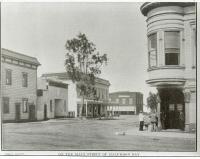
The Debendetti family owned much of the block stretching from Cunhaâs north to the building on the opposite corner, across from the San Benito House. Itâs easily identified today because itâs marked as the âDebenedetti Blockâ?.
From the second floor balcony, the Debenedettis dressed in their finest, stood and watched the spectacle of the 4th of July parades– and horse racing that took place when Main Street was just a dirt road.
Henryâs love of horse racing led to the lifelong habit of driving his old car, the color of dull green, to Bay Meadows Race Track in San Mateo where he spent most of the day. In the 1970s it was easy to identify Henryâs car because there wasnât much traffic moving up and down Main Street. I quickly became aware of him, wearing his rumpled clothes and brown hat. One time I was at Bay Meadows and so was he, and we cordially exchanged greetings.
When I met Henry, he still lived by himself in the old Debendetti Building, on the second floor. I recall walking up the dark staircase to the upper floor where he showed me his books and many albums filled with fading family photos.
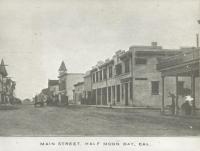 (Photo at left: “The Hen” lived on the second floor of the “Debenedetti Block” building, in the foreground).
(Photo at left: “The Hen” lived on the second floor of the “Debenedetti Block” building, in the foreground).
His biggest regret was that dreams of a college education were crushed when he fell ill with tuberculosis and was shipped off to a special hospital to recover. He was away from Half Moon Bay for a long time and when he returned things were never the same for âthe Henâ?.
Almost every night Henry Debenedetti went to the library to read and to remember where the sweet apricot orchard once stood.
In 1962 you could…..
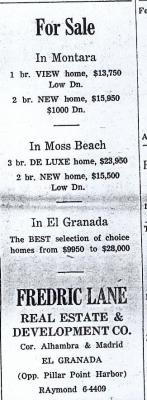
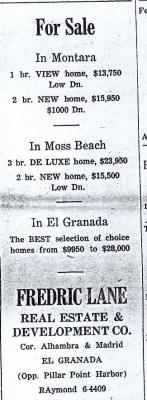 Fred Lane turned the “North” El Granada Train Station into his real estate offices.
Fred Lane turned the “North” El Granada Train Station into his real estate offices. 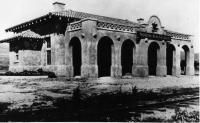 Lane had the memorable habit, I’m told, of gently patting himself on the head while conversing with others. His wife, Blaise, who came from a prominent San Francisco family with Russian roots, wrote children’s books–but in a departure from her usual genre she penned a book about the wife of the warden of San Quentin.
Lane had the memorable habit, I’m told, of gently patting himself on the head while conversing with others. His wife, Blaise, who came from a prominent San Francisco family with Russian roots, wrote children’s books–but in a departure from her usual genre she penned a book about the wife of the warden of San Quentin.

